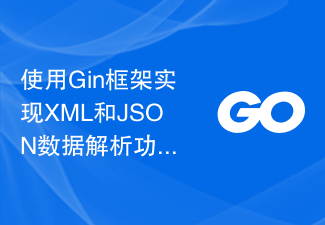 Backend Development
Backend Development Golang
Golang Detailed explanation of Socket and TLS support of Gin framework and its applications
Detailed explanation of Socket and TLS support of Gin framework and its applicationsThe Gin framework is a lightweight Web framework that is easy to use, efficient and fast, and supports Socket and TLS protocols. This article will provide a detailed explanation of the Socket and TLS support of the Gin framework and explore their application in actual projects.
1. Socket support
- Socket overview
Socket is a communication protocol that can transmit data on the network. Socket is a combination of IP address and port number. It is mainly used for inter-process communication to realize the development of network applications.
- Socket support of Gin framework
Gin framework supports WebSocket and Socket programming based on TCP protocol. WebSocket is a full-duplex protocol based on the TCP protocol, which allows the server to actively push data to the client. Socket programming based on the TCP protocol is a protocol based on the transport layer, which can achieve two-way communication between the client and the server. The Socket support of the Gin framework is very practical and can be used to implement real-time communication functions, such as online chat rooms, games, etc.
- Socket usage of Gin framework
In the Gin framework, the Socket function can be implemented by using the gin.Context object. The specific steps are as follows:
- Use
c.Requestin thegin.Contextobject to obtain the HTTP request object; - Call
WebSocketmethod orTCPmethod to create a WebSocket or TCP connection; - Send a message to the client through the
WriteMessageorWritemethod; - Receive messages from the client through the
ReadMessageorReadmethod; - Close the connection using the
Closemethod.
The following is a simple example:
package main
import (
"fmt"
"github.com/gin-gonic/gin"
"github.com/gorilla/websocket"
"net/http"
)
var upgrader = websocket.Upgrader{
CheckOrigin: func(r *http.Request) bool {
return true
},
}
func main() {
router := gin.Default()
router.GET("/ws", func(c *gin.Context) {
conn, err := upgrader.Upgrade(c.Writer, c.Request, nil)
if err != nil {
fmt.Println("error:", err)
return
}
for {
message := []byte("Hello, client!")
err := conn.WriteMessage(websocket.TextMessage, message)
if err != nil {
fmt.Println("Error:", err)
break
}
_, msg, err := conn.ReadMessage()
if err != nil {
fmt.Println("Error:", err)
break
}
fmt.Printf("Message received: %s
", msg)
}
})
router.Run(":8080")
}This example creates a WebSocket connection through c.Writer and c.RequestParameters convert gin.Context objects into http.ResponseWriter and http.Request objects. Then use the upgrader variable to upgrade the HTTP connection to a WebSocket connection. Afterwards, messages are sent to the client through the WriteMessage method and received from the client through the ReadMessage method.
2. TLS Support
- TLS Overview
TLS (Transport Layer Security) is a transport layer security protocol that is used to protect network communications. safety. The TLS protocol ensures confidentiality, integrity and authentication of data transmission. The TLS protocol is the basis of the HTTPS protocol, which uses public key encryption for secure data transmission.
- TLS Support for Gin Framework
Gin Framework supports HTTP and HTTPS servers and provides security through TLS protocol. With the Gin framework's TLS support, web applications can be easily upgraded to HTTPS, thereby improving application security.
- TLS usage of Gin framework
In the Gin framework, you can use the RunTLS method to start the TLS server. Certificate and key files are required to use the RunTLS method. The certificate file is used to verify the identity of the server, and the key file is used to encrypt data transmission. The TLS support of the Gin framework is very practical and provides a very effective security solution for developing web applications with higher requirements.
The following is a simple example:
package main
import (
"github.com/gin-gonic/gin"
"log"
)
func main() {
router := gin.Default()
router.GET("/", func(c *gin.Context) {
c.String(200, "Hello, world!")
})
err := router.RunTLS(":8080", "server.crt", "server.key")
if err != nil {
log.Fatal("Error:", err)
}
}This example uses the RunTLS method to start the HTTPS server. When connecting to a server, the client verifies the server's identity and uses the public key to encrypt the data transfer. The certificate and key files are server.crt and server.key files respectively.
Conclusion
The Gin framework’s Socket and TLS support provides powerful functionality and security for web applications. With Gin framework’s Socket and TLS support, we can easily develop real-time communication applications and secure web applications. It should be noted that when using TLS support, we need to ensure the security of the certificate and key files.
The above is the detailed content of Detailed explanation of Socket and TLS support of Gin framework and its applications. For more information, please follow other related articles on the PHP Chinese website!
 使用Gin框架实现XML和JSON数据解析功能Jun 22, 2023 pm 03:14 PM
使用Gin框架实现XML和JSON数据解析功能Jun 22, 2023 pm 03:14 PM在Web开发领域中,数据格式之一的XML和JSON被广泛应用,而Gin框架则是一款轻量级的Go语言Web框架,它简洁易用且具有高效的性能。本文将介绍如何使用Gin框架实现XML和JSON数据解析功能。Gin框架概述Gin框架是一款基于Go语言的Web框架,它可用于构建高效和可扩展的Web应用程序。Gin框架的设计思想是简洁易用,它提供了多种中间件和插件,使开
 使用Gin框架实现实时监控和报警功能Jun 22, 2023 pm 06:22 PM
使用Gin框架实现实时监控和报警功能Jun 22, 2023 pm 06:22 PMGin是一个轻量级的Web框架,它采用了Go语言的协程和高速路由处理能力,能够快速地开发高性能的Web应用程序。在本文中,我们将探讨如何使用Gin框架实现实时监控和报警功能。监控和报警是现代软件开发的重要部分。在一个大型系统中,可能会有数千个进程、数百个服务器、数以百万计的用户。这些系统产生的数据量常常是惊人的,因此需要一种能够快速处理这些数据并及时警告系统
 使用Gin框架实现API网关和认证授权功能Jun 22, 2023 am 08:57 AM
使用Gin框架实现API网关和认证授权功能Jun 22, 2023 am 08:57 AM在现代化互联网架构中,API网关已经成为了重要的组成部分,被广泛应用于企业和云计算的场景中。API网关的主要作用是统一管理和分发多个微服务系统的API接口,提供访问控制和安全保护,同时也能够进行API文档管理、监控和日志记录等方面的工作。为了更好地保障API网关的安全和可扩展性,一些访问控制和认证授权的机制也被加入到了API网关中。这样的机制可以确保用户和服
 Gin框架的国际化处理和多语言支持详解Jun 22, 2023 am 10:06 AM
Gin框架的国际化处理和多语言支持详解Jun 22, 2023 am 10:06 AMGin框架是一种轻量级的Web框架,它的特点在于快速和灵活。对于需要支持多语言的应用程序来说,Gin框架可以很方便地进行国际化处理和多语言支持。本文将针对Gin框架的国际化处理和多语言支持进行详细阐述。国际化处理在开发过程中,为了兼顾不同语言的用户,很有必要对应用程序进行国际化处理。简单来讲,国际化处理就是对应用程序的资源文件、代码、文本等内容进行适当修改和
 Gin框架的安全性能和安全配置详解Jun 22, 2023 pm 06:51 PM
Gin框架的安全性能和安全配置详解Jun 22, 2023 pm 06:51 PMGin框架是一个轻量级的Web开发框架,它基于Go语言,并提供了强大的路由功能、中间件支持以及可扩展性等优秀的特性。然而,对于任何Web应用程序来说,安全性都是至关重要的因素。在本文中,我们将讨论Gin框架的安全性能和安全配置,以帮助用户确保其Web应用程序的安全性。一、Gin框架的安全性能 1.1XSS攻击预防 跨站点脚本(XSS)攻击是最常见的We
 Gin框架的Socket和TLS支持详解及其应用Jun 22, 2023 am 08:27 AM
Gin框架的Socket和TLS支持详解及其应用Jun 22, 2023 am 08:27 AMGin框架是一个轻量级的Web框架,它简单易用,高效快捷,并且支持Socket和TLS协议。本文将对Gin框架的Socket和TLS支持进行详解,并探讨它们在实际项目中的应用。一、Socket支持Socket概述Socket是一种通信协议,它能够在网络上传输数据。Socket是由IP地址和端口号组合而来的,它主要用于进程间的通信,从而实现网络应用的开发。Gi
 Gin框架的日志存储和查询分析详解Jun 22, 2023 am 08:22 AM
Gin框架的日志存储和查询分析详解Jun 22, 2023 am 08:22 AMGin框架是一款轻量级的Web框架,它的优点在于速度快、易用性高、功能强大,因此被越来越多的开发者所喜爱和使用。作为一个Web应用程序,它一定会产生大量的日志信息,为了更好地对这些日志进行存储和查询分析,我们需要对Gin框架的日志功能进行深入了解和应用。一、Gin框架的日志功能Gin框架提供了两种日志记录方式:分别是控制台输出和文件输出。通过设置Gin框架的
 Gin框架的模板渲染功能详解Jun 22, 2023 pm 10:37 PM
Gin框架的模板渲染功能详解Jun 22, 2023 pm 10:37 PMGin框架是目前非常流行的Go语言Web框架之一。作为一个轻量级的框架,Gin提供了丰富的功能和灵活的架构,使得它在Web开发领域中备受欢迎。其中一个特别重要的功能是模板渲染。在本文中,我们将介绍Gin框架的模板渲染功能,并深入了解它的实现原理。一、Gin框架的模板渲染功能Gin框架使用了多种模板渲染引擎来构建Web应用程序。目前,它支持以下几种模板引擎:


Hot AI Tools

Undresser.AI Undress
AI-powered app for creating realistic nude photos

AI Clothes Remover
Online AI tool for removing clothes from photos.

Undress AI Tool
Undress images for free

Clothoff.io
AI clothes remover

AI Hentai Generator
Generate AI Hentai for free.

Hot Article

Hot Tools

SublimeText3 English version
Recommended: Win version, supports code prompts!

Zend Studio 13.0.1
Powerful PHP integrated development environment

Atom editor mac version download
The most popular open source editor

MinGW - Minimalist GNU for Windows
This project is in the process of being migrated to osdn.net/projects/mingw, you can continue to follow us there. MinGW: A native Windows port of the GNU Compiler Collection (GCC), freely distributable import libraries and header files for building native Windows applications; includes extensions to the MSVC runtime to support C99 functionality. All MinGW software can run on 64-bit Windows platforms.

Dreamweaver Mac version
Visual web development tools




